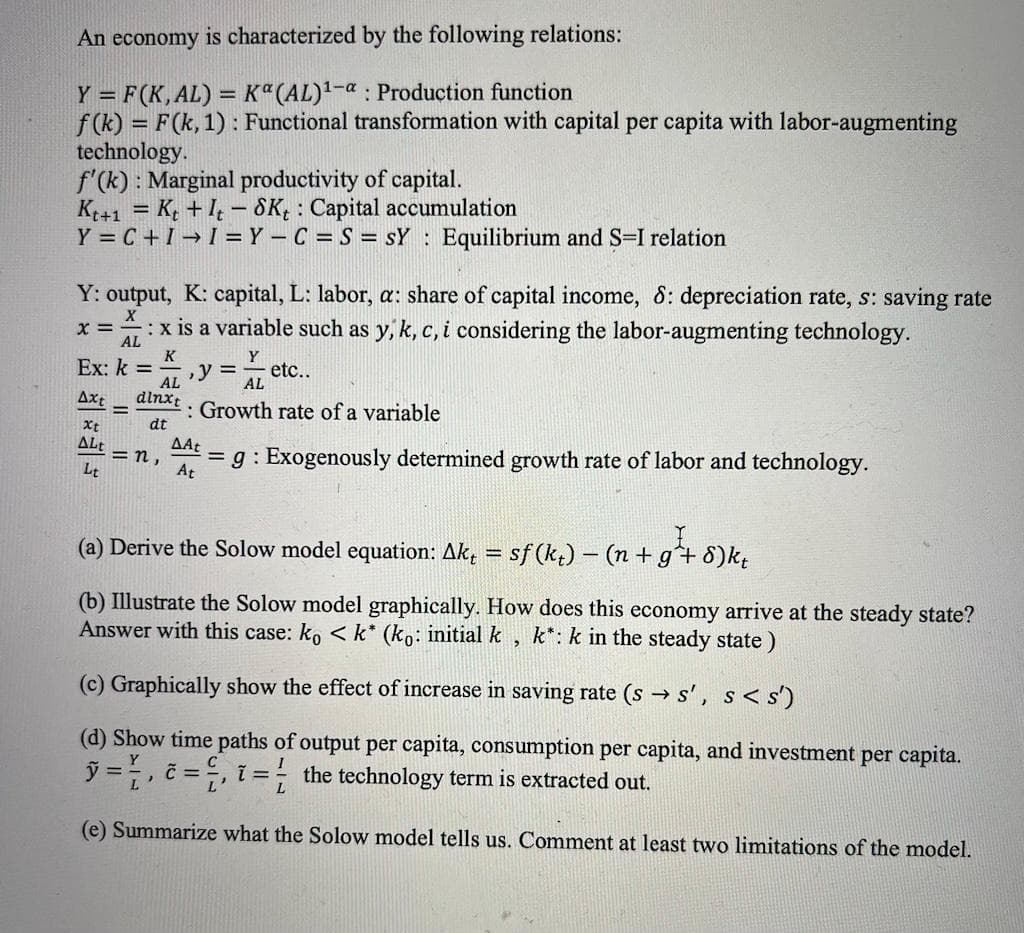An economy is characterized by the following relations: Y = F(K,AL) = Kª(AL)1-a : Production function f(k) = F(k, 1) : Functional transformation with capital per capita with labor-augmenting technology. f'(k) : Marginal productivity of capital. K+1 = K, + I - 8K : Capital accumulation Y = C +I → I = Y – C = S = sY : Equilibrium and S=I relation %3D %3D -
An economy is characterized by the following relations: Y = F(K,AL) = Kª(AL)1-a : Production function f(k) = F(k, 1) : Functional transformation with capital per capita with labor-augmenting technology. f'(k) : Marginal productivity of capital. K+1 = K, + I - 8K : Capital accumulation Y = C +I → I = Y – C = S = sY : Equilibrium and S=I relation %3D %3D -
Chapter2: Production Possibilities Frontier Framework
Section: Chapter Questions
Problem 11QP
Related questions
Question
7

Transcribed Image Text:An economy is characterized by the following relations:
Y = F(K,AL) = Kª(AL)1-a : Production function
f (k) = F(k, 1) : Functional transformation with capital per capita with labor-augmenting
technology.
f'(k) : Marginal productivity of capital.
K+1 = K; + I - SK; : Capital accumulation
Y = C +I → I = Y – C = S = sY : Equilibrium and S=I relation
%3D
Y: output, K: capital, L: labor, a: share of capital income, 8: depreciation rate, s: saving rate
:x is a variable such as y, k, c, i considering the labor-augmenting technology.
x =
AL
K
Y
Ex: k =
etc..
y 3D
AL
AL
Axt
dlnxt
%3D
: Growth rate of a variable
dt
Xt
ALt
=n,
AAt
= g : Exogenously determined growth rate of labor and technology.
At
Lt
(a) Derive the Solow model equation: Ak, = sf (k,) - (n +g+ 8)k;
(b) Illustrate the Solow model graphically. How does this economy arrive at the steady state?
Answer with this case: ko < k* (ko: initial k
k*: k in the steady state)
(c) Graphically show the effect of increase in saving rate (s → s', s< s')
(d) Show time paths of output per capita, consumption per capita, and investment per capita.
ỹ =, č = , i = the technology term is extracted out.
L
(e) Summarize what the Solow model tells us. Comment at least two limitations of the model.
Expert Solution
This question has been solved!
Explore an expertly crafted, step-by-step solution for a thorough understanding of key concepts.
Step by step
Solved in 4 steps with 4 images

Knowledge Booster
Learn more about
Need a deep-dive on the concept behind this application? Look no further. Learn more about this topic, economics and related others by exploring similar questions and additional content below.Recommended textbooks for you



Economics (MindTap Course List)
Economics
ISBN:
9781337617383
Author:
Roger A. Arnold
Publisher:
Cengage Learning



Economics (MindTap Course List)
Economics
ISBN:
9781337617383
Author:
Roger A. Arnold
Publisher:
Cengage Learning